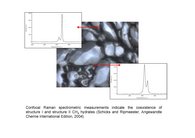Equipment & location: B254
The Micro-Raman Spectroscopy Laboratory (Sections 3.1 and 3.2) uses a Horiba Jobin Yvon LabRAM HR Evolution Raman spectrometer equipped with a motordriven x-y table and an Olympus optical microscope. Depending on the experiment two different laser light sources can be used for investigations on gas hydrates: a Nd:YAG laser providing a 532 nm line and 785 nm wavelength-stabilized laser diode. The confocal technique provides an efficient way to obtain interference-free Raman spectra of specimens embedded in transparent matrix (grain mounts, thin sections) but also for gas hydrate crystals.
Application of Raman spectroscopy in earth sciences:
- identification of mineral phases
- composition of the gas phase in fluid and melt inclusions (qualitative and semi-quantitative)
- detection of anions in fluid inclusions (CO32-, HCO3-, PO43-, BO43- , SO42- , HS-, OH- )
- identification of crystalline dimorphs and polymorphs (e.g., calcite-aragonite; sillimanite- kyanite- andalusite)
Applications in gas hydrate research:
- determination of the composition of gas hydrates (qualitative and semi-quantitative) during formation, growth and equilibrium state
- determination of hydrate structure and cage occupancies
- investigation on hydrate formation kinetics
- mapping of natural and synthesized samples – determination of co-existing phases
For Raman studies at ambient pressure and temperatures between -196°C and 1500°C we use LINKAM stages. For Raman spectroscopic investigation of gas hydrates we use a custom made pressure cell with a volume of about 400 µl which can be used at pressures up to 10 MPa and in the temperature range between -30°C and about 60°C.



